Swati Thiyagarajan is a conservation journalist and author of book Born Wild: Journeys in the Wild Hearts of India and Africa (Bloomsbury India).
What do you say when someone asks you who you are? The usual response is to define ourselves through nationality, race, gender, beliefs, career, and so on. It’s how we see ourselves. However, all of that is just cosmetic because in the blood, the bone, the skin, what we are, who we are is, phylum Chordata, class Mammalia, kingdom Animalia. We are the Human Animal.
For most of the four million years since our genus Homo came into existence we lived wild lives, not so different from our Great Ape family tree, even if we branched off in a completely unique way. We were and still are Born Wild. The act of birth, even if today a baby can be created in a crucible, is wild. That baby still uses the building blocks of sperm and egg and still requires a uterus for growth and development and still comes out a blank slate onto which unfortunately the modern world adds the cosmetic definitions. A new born actually requires only fresh air to breathe, a caretaker’s warm embrace and food. All of which are inextricably linked to our natural environment. It’s only in the last 10 thousand years out of four million, with agriculture and then the industrial and technological revolutions, that we have tried to control and exploit the living planet.
We have in this time destroyed half the world’s forests and more than half of all species. We are essentially erasing nature. When the building blocks that make up all life on earth or nucleotides are the same for the potted palm, the fruit fly and us, but just in different miraculous permutation combinations, we seemed to have missed the point that we are nature.
It reminded me of a conversation I had had with an old aboriginal man.
“Do you feel that in this new modern world one of our greatest problems is our separation from nature?” I asked him. He did not understand my question. I asked him the question in different ways with the help of a translator and he did not understand it. Finally, I realised that he understood the individual words, but not what they meant strung together because in his world, there was no such thing as separation. It couldn’t be because if it was he couldn’t be. Finally, he stopped me and said, “River, ocean, rock, sand, bird, nature… is family. Is me.” He pointed to the world first and then said, “You desecrate that,” then he pointed to himself, “you desecrate this.”“Of all the profound links we have to nature, perhaps our greatest link is with the oceans.”
The oceans are our great universal womb, holding us until the day we die. Without them, we have no oxygen and no rain. In fact, our most ancient ancestor is the Saccorhytus, a wriggly sea creature found 540 million years ago. In fact, she was the ancestor to millions of other species and can be called the mother of biodiversity. In an everyday reminder, our bodies are 60% water.
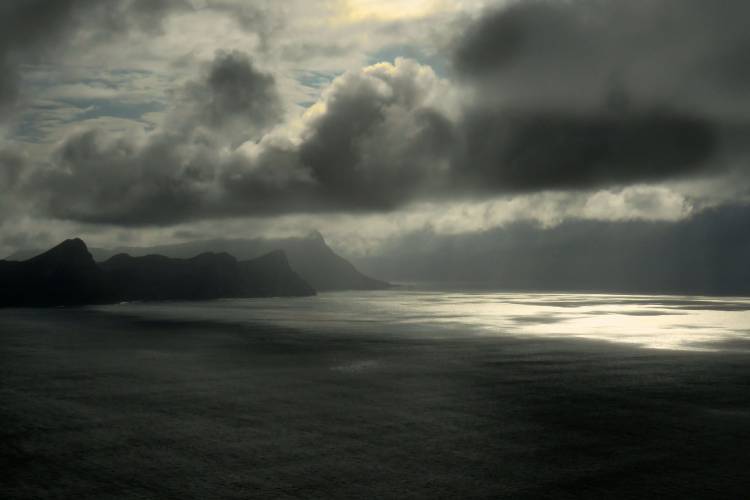
Credit: Craig Foster
And here in South Africa, our links to the ocean are more deep and sacred.“When the world turned hostile with great ice ages and unwelcome climate, our coast, the only place on earth where two great oceanic currents (the Benguela cold current from the Atlantic and the Agulhus warm current from the Indian Ocean) meet, provided a pocket of space for the survival of the human species. It was on this stretch of the Cape Peninsula that we emerged as modern humans. ”
It was here that a 100 000 years ago we truly transformed into who we are today. In the silken blue-green glide of our coastal waters extending from our coastal border with Namibia all the way down towards De Hoop National Marine Reserve we have an extraordinary ecosystem, the kelp forests. Comprised of a variety of giant seaweeds and algae, these plants form vast underwater forests as productive and filled with life as any of the great terrestrial forests.
Kelp is found in nearly all temperate and sub-polar waters of the world and they are amongst the fastest-growing plants in the world. Kelp, however, unlike other plants, don’t have a root system. They have what are called holdfasts that anchor them to rocky sediments in the oceans. Unlike conventional plants they don’t need a root system to bring up nutrients. They can absorb it directly from the water around them. Even if you have never dived beneath those golden fronds to fly through its underwater splendor, you have seen at least one of the most common varieties, the Eklonia maxima, as it washes up on our beaches.
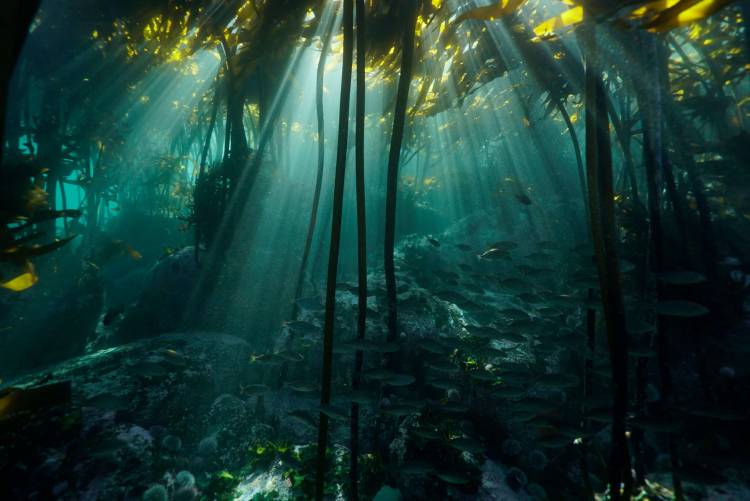
The underwater forests. Credit: Craig Foster
The kelp is a near-shore ecosystem, extending from the fringes of the intertidal zones, or the rock pools that fill and ebb as the tides wax and wane, to not more than 3km out to the ocean. The bulk of their spread is within a few hundred metres. With a top canopy of ribbon-like fronds that floats on the surface, long stipes that rise and prostate kelp that spreads at the bottom, these forests provide a safe habitat for thousands of animals and smaller seaweeds. They are also a nursery and a haven for baby animals. Inside this forest, under the water, is a magic kingdom of wonderous creatures whose lives are as dramatic and as dynamic as any of our own. It’s not just a kelp forest but The Great African Seaforest.
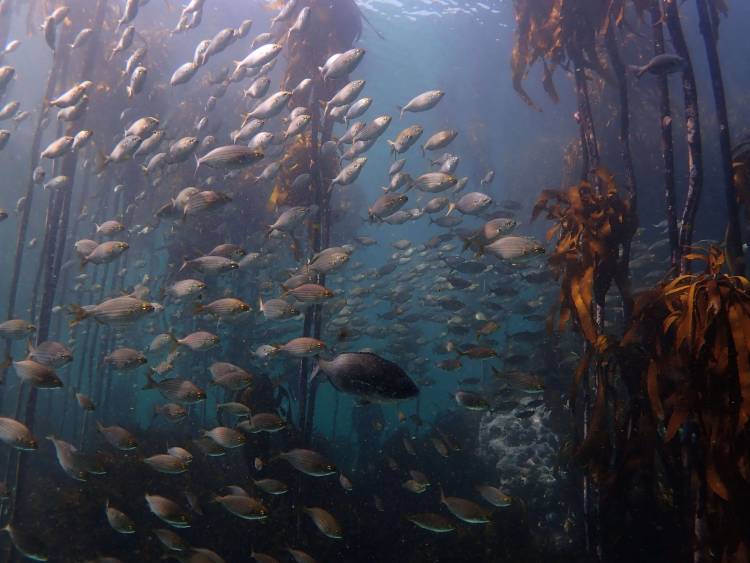
The Great African Seaforest. Credit: Craig Foster
As this forest is found in nutrient-rich waters, our coasts are some of the most biodiverse with great endemism on the African continent.“These underwater forests are a keystone organism which means that without them, this ecosystem would cease to exist. ”
They protect our shores and coastlines from deadly storm surges and clean the water around them. It’s this rich biodiversity that enabled us to forage the oceans for protein-rich foods and it is perhaps here that the first modern human family learnt to swim using the kelp-like flotation devices. Science has proved beyond a doubt that it is on these shores that we as a species had one of our greatest breakthroughs, the ability to inscribe what was in our thoughts onto something outside our minds. It sounds like such a simple thing today when every person is running around expressing themselves through selfies, but at a 100 000 years ago, when someone made that enormous leap from simply seeing and holding thoughts and images in their heads to representing it physically outside the brain, that was the “giant leap for mankind” which enabled down the line our first step on the moon. Remember that except for the human animal no other animal has ever represented in form, art or writing its internal thoughts and processes. Language, culture, tool use, community bonds, even a certain symboling is found in the non- human animal world. It’s only our ability to physically express our minds onto an external slate that makes us and has made us the most formidable species on this planet.
Here on these shores that first family, also now proven to be the ancestors of us all, that is every single person on the planet no matter who you are, enabled a pact of 6 000 generations with the wild world. It’s this precious natural heritage that is our true heritage.
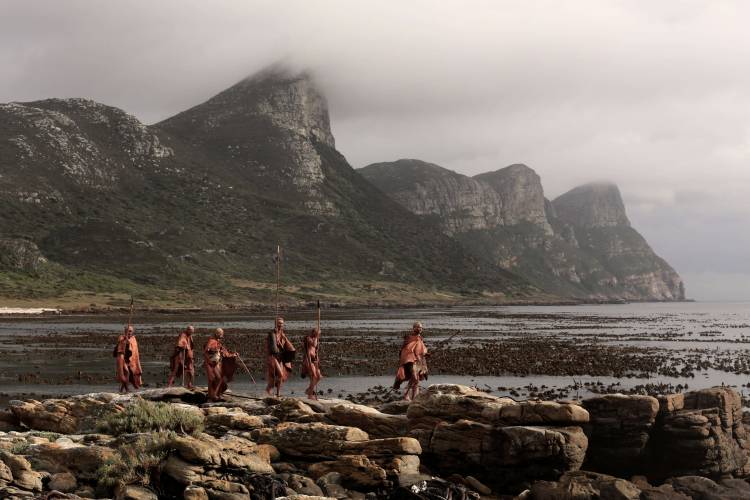
Reconstructed photo of the first family on our coasts. Credit: Craig Foster
We celebrate with such pride our achievements and our creations like a 1000-year-old church is somehow more crucial to the human psyche than a million-year-old forest. This is because of a skewed understanding of what our heritage truly is.
Today we live in a world where we are staring the sixth great mass extinction in the eye whilst millions of us have no access to clean air and water. Our oceans are being over-exploited and even our Great African Seaforest faces threats from poaching, over-fishing, pollution and climate change.
We fill our time with gadgets and consumer goods and expend all of our energy striving for a basic living. Community bonds have snapped, we are suspicious and angry with anyone who is different to what we consider normal or ours. Underpinning all of this is a great ecological depression. It’s become so widespread that a new word has entered our lexicon, psychoterratica, or a feeling of deep separation from nature. As our lives destroy the habitat around us and as we place ourselves as the most important and indeed the only important species on the planet, this separation has never been greater. We function like all of our artificial constructs are important to our survival while nature is a secondary consideration. This is in absolute contravention of our wild selves.“Our physical and psychological selves are embedded in the wild world. ”
Growing up in concrete jungles, away from the outdoors, separate to communities who don’t eat, worship or look like you, trapped in a system that makes you a drone , feeding on food that breaks you down instead of building you up, where we recognize brands and cars and phones and not the bird that has come to sing season after season, fearing the ocean instead of embracing its wonder, eschewing wild spaces to a point where our bare feet barely touches soil anymore, is it any wonder there is such anger, hatred, violence?. If we place ourselves above our non-human animal brethren, is it any wonder that we have created hierarchies amongst ourselves where some humans deem themselves superior to others?“If we can slash, burn, pollute and poison our original mother, can we really be surprised at our unraveling psyches? ”
Years of seeing the wild and the peoples of the wild who still live true lives, the indigenous peoples of the world, as “savage” and only the human with the computer as “evolved” has skewed our priorities. We have yet to realise that if everything created by humans crumbled tomorrow, we would still survive. There might certainly be war and anarchy as that’s become the technological human’s default setting, but greater numbers of people will actually survive as opposed to the natural world crumbling. A burning Notre Dame, while a shame, is not the catastrophe the burning Amazon is or the ravaged oceans.“Here in South Africa we are blessed to live with this wild ecosystem right on our doorstep. We have the opportunity to heal our separation from nature on a daily basis and we have the duty to help bring about that healing for those who feel they lack the access. ”
If we can first acknowledge that we are the human animal, if we can acknowledge that we are all one people and celebrate the link we have with 6 000 generations living in harmony with nature standing behind us, we can start the journey towards understanding our true heritage.
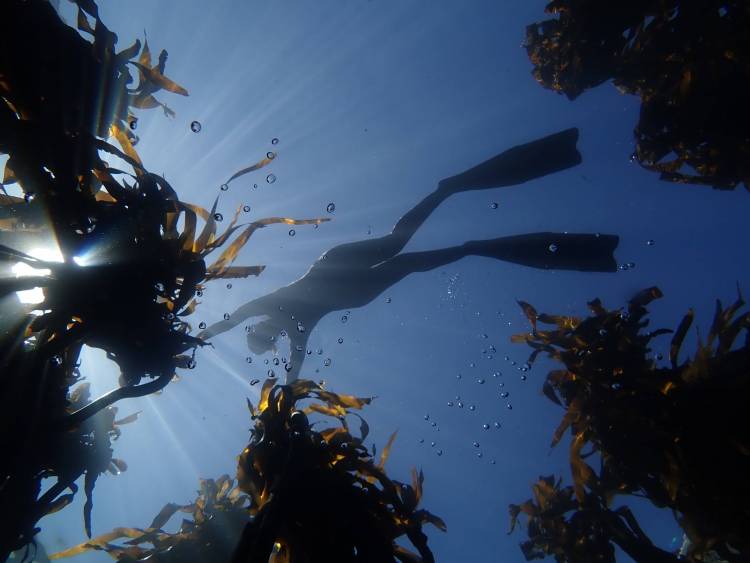
Daily immersion in nature to re-establish deep bonds. Credit: Craig Foster
It doesn’t come with wood, stones and glass but with oceans, forests and mountains. It comes in our right to breathe clean air, our right to clean water, our right to nutritious food and our right to wild spaces shared with the non-human animal beings who have the very same rights.
A friend called me yesterday and told me about a conversation she had with her teenage daughter. When her daughter was asked what her plan was for her presentation at career day in school, her daughter said, “What’s the point Ma, we won’t have a planet left anyway by the time I grow up.” The despair is real.
It is that simple and that crucial. We need to change our definition of ourselves and of our heritage and we need to do it now because our children are waiting and they are frightened.
https://conservationaction.co.za/recent ... -heritage/


